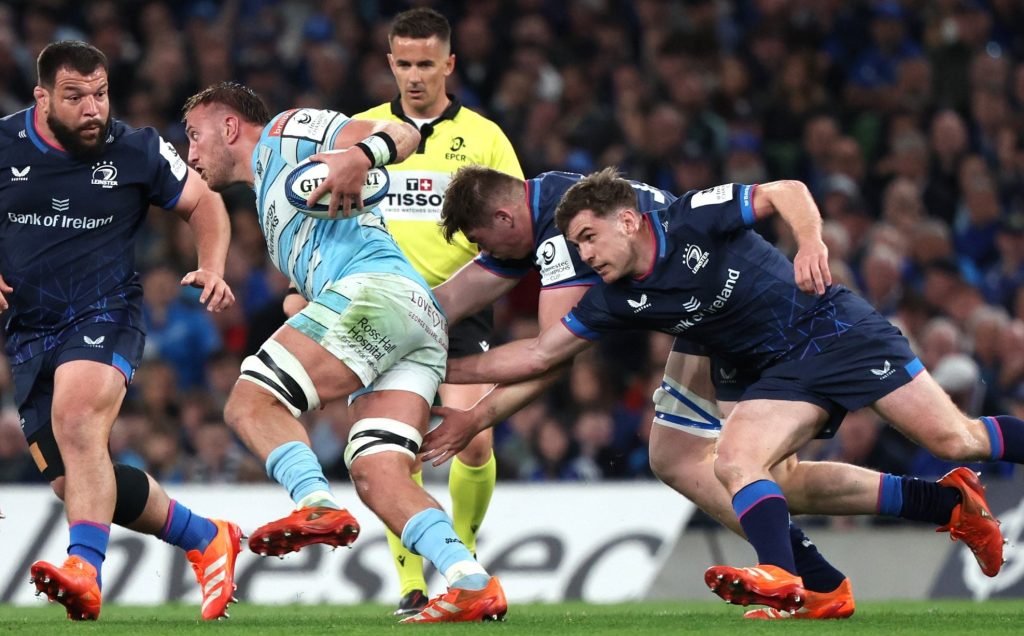
Leinster’s defence is not so much stingy as savage. Their front-liners have surged to the semi-final of the Champions Cup after ‘nilling’ two intrepid teams, Harlequins and Glasgow Warriors, in succession. And while opponents have regretted a failure to fire shots, the truth is that they have been outgunned.
With the ingenious Jacques Nienaber at the helm, Leinster’s defensive blitz is probably the most aggressive on the planet. Such a system lives and dies on conviction – remember how England’s ‘hammer’ faltered over an autumn of uncertainty – and Nienaber has instilled a resolute confidence.
For one brief snapshot of how Leinster can influence matches, we can head back to December and a group game against Bristol Bears. Track Garry Ringrose from here…

…as he follows a pull-back pass from Fitz Harding to clatter AJ MacGinty:
Not only did this perfectly legal tackle derail Bristol’s attack. It also caused MacGinty, a critical playmaker, to withdraw from the game after just three minutes. Now, Nienaber is not urging his players to cause injury. But he does want them to disrupt rivals with tenacity, commitment and proactive decisions.
This display was among Leinster’s least convincing in the Champions Cup this season, and they have progressed ominously over the ensuing months. The defeats of Harlequins and Glasgow married slick attack with suffocating defence. And for Northampton Saints to stand any chance of landing a huge upset on Saturday – Leinster are 21-point favourites – they will need to beat the blitz on multiple occasions.
Sam Vesty will have been plotting ways to do this since Saints thrashed Castres to set up a rematch with the team that ousted them at the semi-final stage a year ago. Expect them to zigzag within the 15-metre channels, with Alex Mitchell scampering laterally to fix defenders close to the ruck.
Kicking wide to kick again is another ploy that can be used to find space in behind the blitz. England attempted this in the opening stages of their match against South Africa in November, indirectly leading to their first try. Marcus Smith strikes across the pitch to Ollie Sleightholme, who sends the ball down the left flank beyond an aggressive back-field pendulum:
Another potential plan concerns the sort of phase shape Bristol were running in the above clip of Ringrose whacking MacGinty. Firstly, watch this try scored by Gareth Anscombe in Gloucester’s thrashing of Exeter Chiefs last weekend:
It comes from Anscombe and Seb Atkinson circling around first-receiver Jack Clement together:

Clement then plays a pull-back behind Freddie Thomas that goes across Anscombe, who would normally receive it, to Atkinson. Exeter are outflanked from there as Atkinson transfers the ball to Santiago Carreras:
In this case, Gloucester benefit from a happy accident as Atkinson adapts on the hoof. But stacking players in a deeper position from this familiar set-up is a tactic that has been used against aggressive defences.
Watch here, in the Premiership Cup final, how Bath flood through Exeter. Ciaran Donoghue stands at first-receiver and threads a pass between Austin Emens, who is hitting a hard line, and Cameron Redpath, who is sitting deeper:
This is how the ball gets straight to Ruaridh McConnochie:

Sale Sharks, along with Saracens and Exeter, are one of three Premiership sides who favour an aggressive defensive press. Watch here, during a game in Salford last season, how Gloucester find space on the outside:
This is a more intricate “stack”, which sees Mark Atkinson throw a pass behind Max Llewellyn and across both George Barton and Josh Hathaway to Jake Morris:

Now, to rewind again to the Ringrose hit on MacGinty, imagine the effect of Harding throwing a pull-back behind Kalaveti Ravouvou but past MacGinty to Benhard Janse van Rensburg. Ringrose might have been wrong-footed, isolating Jordan Larmour beyond him:

Deep, predictable passing against a blitz defence is asking for trouble and will lead to a side being tackled well behind the gain-line. But there are several ways to make life more difficult for shooting defenders. The key to this Scarlets try against Leinster last weekend is how Blair Murray fades on the pass from Johnny Williams, allowing him to slip past Andrew Osborne:
Good 1st Phase strike try for Scarlets #SCAvLEI . nice drift by Murray to allow the pass beat the defender/9 on the loop causes Defence issues. #URCGOpic.twitter.com/AWlz70cRCA
— Brett Igoe (@brettruganalyst) April 28, 2025
Leinster’s blitz defence is multi-faceted. They are brawny close to the breakdown and compete hard on the floor to disrupt the rhythm of opponents, both jackalling and barging into bodies when the ball appears to be won by the attacking team. The latter is a feature of Nienaber’s coaching. Their aim will be to mess up Mitchell’s platform.
If and when Leinster’s line is broken, they scramble desperately. To find space in the first instance, Northampton will need to be brave. They were frustrated with early errors and an overly cautious mindset last time they met Leinster, so we can expect them to give it a crack.
See this botched play against Castres, which sees Mitchell feign a pass towards a three-man pod of forwards on the far side of the breakdown before spinning to find Fin Smith, who has ghosted to the near side:
Seven minutes later, we get an even more intricate first-phase move. After Juarno Augustus backs away from the receiver position at a line-out, he is found by Mitchell and plays a pull-back to Smith behind Burger Odendaal. Another pull-back behind Fraser Dingwall finds Tommy Freeman and Castres commit a deliberate knock-on:
This last example is a three-phase strike, which ends up with Smith edging behind a four-man pod that has Dingwall nestled among forwards:

After a pull-back, Smith, George Furbank and Freeman combine to release Josh Kemeny on the edge:
Saints have been hit by injuries ahead of Saturday and will be missing Odendaal and Furbank as well as George Hendy, Sleightholme and Tom Pearson. They are facing a monumental task, yet will back their attack to cause trouble.
Rory Hutchinson, who partners Dingwall in midfield, is renowned around the Premiership as an immensely skilful distributor on the gain-line, whether that be pulling passes behind lead runners or playing short tip-ons.
The selection of Tom Litchfield, a natural centre, on the wing over Tom Seabrook suggests that Vesty wants his wide men to roam in-field and link attacks.
Leinster’s blitz is an imposing challenge. But Saints have promised not to die wondering. Their chief weapons against one of the world’s most aggressive defences will be intricate angles, deception and crisp ball movement. And it should be a compelling watch.
Match images from Premier Sports and TNT Sport

Leinster’s defence is not so much stingy as savage. Their front-liners have surged to the semi-final of the Champions Cup after ‘nilling’ two intrepid teams, Harlequins and Glasgow Warriors, in succession. And while opponents have regretted a failure to fire shots, the truth is that they have been outgunned.
With the ingenious Jacques Nienaber at the helm, Leinster’s defensive blitz is probably the most aggressive on the planet. Such a system lives and dies on conviction – remember how England’s ‘hammer’ faltered over an autumn of uncertainty – and Nienaber has instilled a resolute confidence.
For one brief snapshot of how Leinster can influence matches, we can head back to December and a group game against Bristol Bears. Track Garry Ringrose from here…

…as he follows a pull-back pass from Fitz Harding to clatter AJ MacGinty:
Not only did this perfectly legal tackle derail Bristol’s attack. It also caused MacGinty, a critical playmaker, to withdraw from the game after just three minutes. Now, Nienaber is not urging his players to cause injury. But he does want them to disrupt rivals with tenacity, commitment and proactive decisions.
This display was among Leinster’s least convincing in the Champions Cup this season, and they have progressed ominously over the ensuing months. The defeats of Harlequins and Glasgow married slick attack with suffocating defence. And for Northampton Saints to stand any chance of landing a huge upset on Saturday – Leinster are 21-point favourites – they will need to beat the blitz on multiple occasions.
Sam Vesty will have been plotting ways to do this since Saints thrashed Castres to set up a rematch with the team that ousted them at the semi-final stage a year ago. Expect them to zigzag within the 15-metre channels, with Alex Mitchell scampering laterally to fix defenders close to the ruck.
Kicking wide to kick again is another ploy that can be used to find space in behind the blitz. England attempted this in the opening stages of their match against South Africa in November, indirectly leading to their first try. Marcus Smith strikes across the pitch to Ollie Sleightholme, who sends the ball down the left flank beyond an aggressive back-field pendulum:
Another potential plan concerns the sort of phase shape Bristol were running in the above clip of Ringrose whacking MacGinty. Firstly, watch this try scored by Gareth Anscombe in Gloucester’s thrashing of Exeter Chiefs last weekend:
It comes from Anscombe and Seb Atkinson circling around first-receiver Jack Clement together:

Clement then plays a pull-back behind Freddie Thomas that goes across Anscombe, who would normally receive it, to Atkinson. Exeter are outflanked from there as Atkinson transfers the ball to Santiago Carreras:
In this case, Gloucester benefit from a happy accident as Atkinson adapts on the hoof. But stacking players in a deeper position from this familiar set-up is a tactic that has been used against aggressive defences.
Watch here, in the Premiership Cup final, how Bath flood through Exeter. Ciaran Donoghue stands at first-receiver and threads a pass between Austin Emens, who is hitting a hard line, and Cameron Redpath, who is sitting deeper:
This is how the ball gets straight to Ruaridh McConnochie:

Sale Sharks, along with Saracens and Exeter, are one of three Premiership sides who favour an aggressive defensive press. Watch here, during a game in Salford last season, how Gloucester find space on the outside:
This is a more intricate “stack”, which sees Mark Atkinson throw a pass behind Max Llewellyn and across both George Barton and Josh Hathaway to Jake Morris:

Now, to rewind again to the Ringrose hit on MacGinty, imagine the effect of Harding throwing a pull-back behind Kalaveti Ravouvou but past MacGinty to Benhard Janse van Rensburg. Ringrose might have been wrong-footed, isolating Jordan Larmour beyond him:

Deep, predictable passing against a blitz defence is asking for trouble and will lead to a side being tackled well behind the gain-line. But there are several ways to make life more difficult for shooting defenders. The key to this Scarlets try against Leinster last weekend is how Blair Murray fades on the pass from Johnny Williams, allowing him to slip past Andrew Osborne:
Good 1st Phase strike try for Scarlets #SCAvLEI . nice drift by Murray to allow the pass beat the defender/9 on the loop causes Defence issues. #URCGOpic.twitter.com/AWlz70cRCA
— Brett Igoe (@brettruganalyst) April 28, 2025
Leinster’s blitz defence is multi-faceted. They are brawny close to the breakdown and compete hard on the floor to disrupt the rhythm of opponents, both jackalling and barging into bodies when the ball appears to be won by the attacking team. The latter is a feature of Nienaber’s coaching. Their aim will be to mess up Mitchell’s platform.
If and when Leinster’s line is broken, they scramble desperately. To find space in the first instance, Northampton will need to be brave. They were frustrated with early errors and an overly cautious mindset last time they met Leinster, so we can expect them to give it a crack.
See this botched play against Castres, which sees Mitchell feign a pass towards a three-man pod of forwards on the far side of the breakdown before spinning to find Fin Smith, who has ghosted to the near side:
Seven minutes later, we get an even more intricate first-phase move. After Juarno Augustus backs away from the receiver position at a line-out, he is found by Mitchell and plays a pull-back to Smith behind Burger Odendaal. Another pull-back behind Fraser Dingwall finds Tommy Freeman and Castres commit a deliberate knock-on:
This last example is a three-phase strike, which ends up with Smith edging behind a four-man pod that has Dingwall nestled among forwards:

After a pull-back, Smith, George Furbank and Freeman combine to release Josh Kemeny on the edge:
Saints have been hit by injuries ahead of Saturday and will be missing Odendaal and Furbank as well as George Hendy, Sleightholme and Tom Pearson. They are facing a monumental task, yet will back their attack to cause trouble.
Rory Hutchinson, who partners Dingwall in midfield, is renowned around the Premiership as an immensely skilful distributor on the gain-line, whether that be pulling passes behind lead runners or playing short tip-ons.
The selection of Tom Litchfield, a natural centre, on the wing over Tom Seabrook suggests that Vesty wants his wide men to roam in-field and link attacks.
Leinster’s blitz is an imposing challenge. But Saints have promised not to die wondering. Their chief weapons against one of the world’s most aggressive defences will be intricate angles, deception and crisp ball movement. And it should be a compelling watch.
Match images from Premier Sports and TNT Sport













